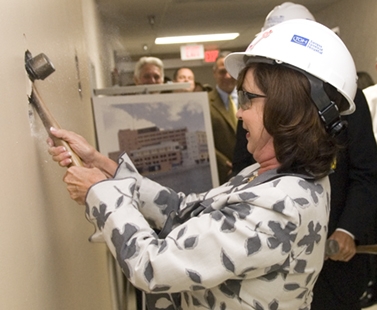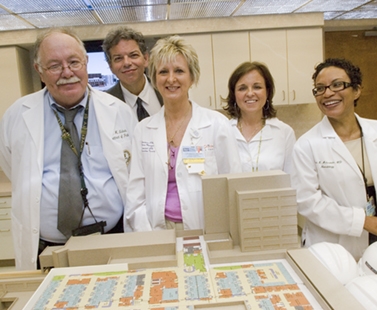Tiny Babies, Big Priority
Construction begins on state-of-the-art neonatal nursery

Pam Muma swings a hammer at the NICU wall-breaking ceremony.
The dream of building a world-class neonatal unit for Tampa Bay’s tiniest babies is well on its way to reality.
Donning hardhats and safety glasses, Pam and Les Muma swung their sledgehammers with gusto, creating two big holes in a wall to signal the beginning of construction on the Jennifer Leigh Muma Neonatal Intensive Care Unit at Tampa General Hospital. The $35-million project – a tangible sign of the partnership between USF Health and TGH to transform research and care for newborns – will completely redesign and expand Tampa General’s existing neonatal nursery. Construction is expected to be complete in early 2011.
Physicians, nurses and other clinicians, hospital and university officials, and construction team members gathered March 31 on the fourth floor of Tampa General’s West Pavilion for the construction kick-off. They nibbled cookies with pink and blue icing in the shape of baby booties and sipped on non-alcoholic champagne. They reviewed the tabletop model of the 53,000 square-foot unit, which will increase the current NICU from 52 beds grouped in open areas to 82 beds in private rooms and a 12-bed transitional nursery.
The new NICU is being funded in part by the Mumas’ generous $6 million gift to USF Health – a donation in memory of their daughter Jennifer Leigh Muma, who died in a neonatal nursery. Their gift, one of the largest in Florida to support research and care for newborns, has a total impact of $14 million after eligible state and internal USF matches. It supports a USF-TGH initiative to build research and medical teams, laboratories at USF Health and an expanded NICU to advance the care and well-being of premature babies.
In addition, the TGH Foundation capital campaign, “Tiny babies. Big Priority,” has raised more $7.6 million towards the NICU renovation. That includes more than $170,000 brought in by a physician campaign led by Robert Nelson, MD, chair of USF Pediatrics; David Keefe, MD, chair of USF Obstetrics and Gynecology; and Thomas Bernasek, MD, vice chair of the TGH Medical Staff.

Dr. Lewis Rubin, who holds the Pamela S. and Leslie M. Muma Endowed Chair in Neonatology at USF, says the redesigned NICU will be family-centered while employing the latest technology.
“Everyone here today is part of the team that will make this dream happen,” Pam Muma said. “We want to help any family who experiences a situation similar to ours and do all we can to make sure these smallest, sickest children go home healthy.”
“This day is special and there is also an emotional aspect,” Les Muma said. “We wanted our daughter’s name to live on, and she will live on through this.”
Lewis Rubin, MD, who joined USF to fill the Pamela S. and Leslie M. Muma Endowed Chair in Neonatology, said the new NICU has been planned with the latest research on NICU design and environment in mind. Input was solicited from physicians, nurses, respiratory therapists, housekeeping staff, traffic engineers, interior designers and focus groups were held with the parents of premature babies to create a place that will be welcoming for families and maximize the comfort and well-being of fragile infants in need of critical care.
“Of the three neonatal intensive care units I’ve helped plan, this one by far has been the best at involving in its design all the people who will be using the space,” said Dr. Rubin, medical director of TGH’s NICU. “The Jennifer Leigh Muma Neonatal Intensive Care Unit will absolutely be a world-class newborn center. It will be baby and family friendly, while taking advantage of the latest technology in telecommunications and bioinformatics.”

Jim Warren, Chairman of the Board of the Florida Health Sciences Center, thanked attendees for the work they do everyday “to take care of this very vulnerable patient population.”
The redesigned NICU will join a growing trend in the care of premature babies – private rooms that strive to replicate the relatively quiet, nurturing environment of the mother’s womb and emphasize family-centered care whenever medically possible. Traditionally, NICUs have been modeled around life-saving equipment with isolettes in one big room leaving little privacy for parent-infant bonding or confidential medical discussions.
Evidence is mounting to suggest that premature babies thrive better in private rooms than in group areas with harsher lights, louder noises, more traffic and other excessive stimuli, Dr. Rubin said. The private rooms in the redesigned NICU will include a place for parents to sleep, ambient lighting, and noise kept low enough for babies to recognize parents’ voices. Windows will allow nurses to see into the rooms, and hand-held PDAs will let them monitor infants and communicate with other team members from anywhere in the NICU. At the same time, the unit will incorporate common areas where parents can gather to socialize and support one another, and siblings can play.

L to R: USF Pediatrics Chair Dr. Robert Nelson, Dr. Lewis Rubin, TGH NICU nurse manager Pam Sanders, Dr. Laura Haubner and Dr. Terri Ashmeade look over the construction model.
Since the Mumas’ gift was announced two and a half years ago, USF Health has opened the Lisa Muma Weitz Advanced Microscopy and Cell Imaging Core, a state-of-the-art laboratory with applications for basic and translational research in neonatology, pediatrics and perinatology. USF has also recruited key members of the research and medical team, including Dr. Rubin and recently Michael Fant, MD, PhD, professor of pediatrics with research expertise in fetal growth and placental development.
Stephen Klasko, MD, MBA, CEO for USF Health and dean of the College of Medicine, said the Mumas’ vision and leadership will create a brighter future for premature babies receiving care in the Tampa Bay area. Their gift will help translate research into the best evidence-based treatment for newborns, he said.
“It shows that when a university and a hospital are committed to excellence in education, research and clinical care, they can achieve so much more together than either could do alone,” Dr. Klasko said. “This kind of partnership is what makes communities great.”

Pam and Les Muma’s generous gift in memory of their daughter has been a catalyst in the USF-TGH partnership to transform newborn research and care.
– Story by Anne DeLotto Baierr, USF Health Communications
– Photos by Eric Younghans, USF Health Communications

